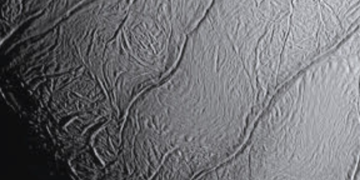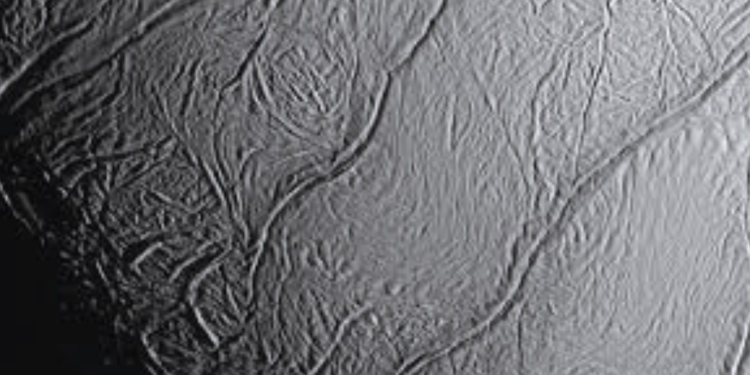Enceladus, a captivating moon of Saturn, has long held the attention of astrobiologists due to its intriguing features. One such feature is the enigmatic set of parallel fractures on its south pole, nicknamed “tiger stripes” for their striped appearance. First observed by NASA’s Cassini spacecraft in 2005, these stripes have become a key target in the quest to understand Enceladus’ internal makeup and its potential to harbor life.

Tiger Stripes: A Window into a Hidden Ocean
The tiger stripes are more than just a striking visual anomaly. They are believed to be connected to ongoing geological activity within Enceladus, possibly linked to a vast subsurface ocean of liquid water. This subsurface ocean is thought to be shielded from the harsh environment of space by a layer of ice, creating a potential habitat for extraterrestrial life.
Cryovolcanism and the Elusive Plume
The tiger stripes are associated with a fascinating phenomenon called “cryovolcanism,” where icy material erupts from the moon’s interior. These eruptions, concentrated around the stripes, spew water vapor and ice particles into space, forming a vast plume that engulfs Enceladus’ south pole. The brightness of this plume, along with the activity of the jets that produce it, exhibits intriguing fluctuations. These fluctuations appear to follow a pattern that coincides with Enceladus’ 33-hour orbital period around Saturn.
Tidal Influence: A Piece of the Puzzle
Scientists initially theorized that the tidal forces exerted by Saturn played a key role in the activity of the tiger stripes. The theory proposed that as Enceladus orbited its giant neighbor, the gravitational pull would cause the moon to flex, creating stress on the tiger stripes. This stress, in turn, was thought to trigger increased activity along the stripes, leading to more vigorous eruptions and a brighter plume.
However, this theory had a significant shortcoming. It couldn’t explain the observed time lag between the peak tidal stress on Enceladus and the peak brightness of the plume. The plume’s peak brightness appeared to occur hours after the tidal stress had reached its maximum.
New Simulations Offer a Fresh Perspective
A recent breakthrough has come in the form of a sophisticated computer simulation developed by a team led by Alexander Berne at Caltech. This simulation takes a new approach, analyzing not only the tidal forces acting on Enceladus but also the movement along the tiger stripes themselves. The simulation incorporates a crucial factor: friction.
Friction and Strike-Slip Motion
Friction plays a significant role in how geological features like faults behave under stress. The simulation considers the effect of friction on the faults within the tiger stripes. Friction influences how much movement (slip) occurs along these faults when subjected to the compressional and shearing stresses caused by the tidal forces from Saturn.
Matching Observations, Unveiling Secrets
The results of the simulation are compelling. When compared to real-world observations of Enceladus, the simulation successfully replicates the variations in plume brightness and surface temperature across the moon’s orbit. This alignment suggests that the jets and the plume’s brightness fluctuations are likely controlled by a process called “strike-slip motion.” Strike-slip motion occurs when the opposing sides of a fault slide horizontally past each other, similar to what happens along Earth’s San Andreas fault. The simulation suggests that tidal forces cause this strike-slip motion along the tiger stripes, leading to variations in the plume activity as Enceladus orbits Saturn.
This new research offers a critical piece to the puzzle of Enceladus. By linking the geological activity on the surface, manifested by the tiger stripes, to the variations in the plume emanating from the subsurface ocean, scientists are gaining valuable insights into the inner workings of this intriguing moon. The ongoing study of the tiger stripes and the plume holds immense promise for unraveling the secrets of Enceladus’ internal ocean and its potential to support life beyond Earth.



















